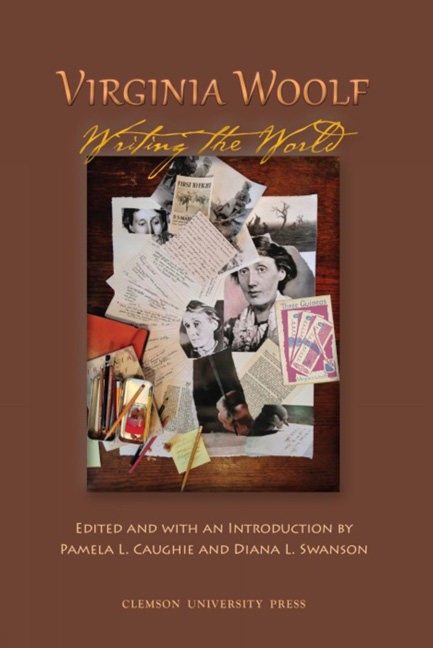Book contents
- Frontmatter
- Table of Contents
- Introduction
- Acknowledgmen
- Abbreviation
- WAR AND PEACE
- WORLD WRITER(S)
- ANIMAL AND NATURAL WORLD
- “And the donkey brays”: Donkeys at Work in Virginia Woolf
- Companion Creatures: “Dogmanity” in Three Guineas
- Virginia Woolf's Object-Oriented Ecology
- The Bodies In/Are The Waves
- Stretching our “Antennae”: Converging Worlds of the Seen and the Unseen in “Kew Gardens”
- “The Problem of Space”: Embodied Language and the Body in Nature in To the Lighthouse
- “Whose Woods These Are”: Virginia Woolf and the Primeval Forests of the Mind
- WRITING AND WORLDMAKING
- Notes on Contributors
- Conference Program
- Appendix: Virginia Woolf Conference Exhibit Items, Newberry Library
“Whose Woods These Are”: Virginia Woolf and the Primeval Forests of the Mind
from ANIMAL AND NATURAL WORLD
- Frontmatter
- Table of Contents
- Introduction
- Acknowledgmen
- Abbreviation
- WAR AND PEACE
- WORLD WRITER(S)
- ANIMAL AND NATURAL WORLD
- “And the donkey brays”: Donkeys at Work in Virginia Woolf
- Companion Creatures: “Dogmanity” in Three Guineas
- Virginia Woolf's Object-Oriented Ecology
- The Bodies In/Are The Waves
- Stretching our “Antennae”: Converging Worlds of the Seen and the Unseen in “Kew Gardens”
- “The Problem of Space”: Embodied Language and the Body in Nature in To the Lighthouse
- “Whose Woods These Are”: Virginia Woolf and the Primeval Forests of the Mind
- WRITING AND WORLDMAKING
- Notes on Contributors
- Conference Program
- Appendix: Virginia Woolf Conference Exhibit Items, Newberry Library
Summary
Judith Allen's interrogation of the multiple meanings of “wildness” in Woolf's work concentrates mostly on grasses and turf and only glancingly mentions forests, which she categorizes with other wild elements as being “outside” the pale of civilization's pavements (69). The impenetrable forest has long been an archetype for human bewild erment: from Dante's dark wood and Spenser's Red Cross Knight in the Wood of Error to Luke Skywalker on Dagobah. John Berger suggests that for Heidegger the forest was “a metaphor for all reality—and the task of the philosopher was to find the weg, the woodcutter's path through it” (126). For Berger the forest is a place in between, where the diff erence in scale between the lives of insects and those of ancient trees creates a kind of comparable suspension in time, a place where we seek protective shelter but which obliges us “to recognize how much is hidden” (127).
In many ways the environmental antithesis of gardens—wild instead of cultivated, seemingly infinite rather than contained, places of mystery and loneliness as opposed to sites of conventional courtship—forests, and their constituent parts, trees and leaves, have some complex metaphorical valences in Virginia Woolf's work. While a few basic patterns for forest associations can be mapped, in many cases forests are endowed with a variety of meanings so diverse as to seem to purposefully dissolve preconceived generalities, a practice of complicating and undercutting dichotomies brilliantly articulated by Derek Ryan in his new book, Virginia Woolf and the Materiality of Theory. This paper examines the multifarious uses of the term “forest” in Woolf's published prose in a counter-phenomenological movement: from exterior extension to inner consciousness, collating glimpses of associations without attempting to impose any nefarious allegorical system.
Forests are often a trope for spatial extension in Woolf. We see this from the first in The Voyage Out (1915) where references to the immensity of the South American forest bracket the text;…
- Type
- Chapter
- Information
- Virginia Woolf: Writing the World , pp. 173 - 178Publisher: Liverpool University PressPrint publication year: 2015



